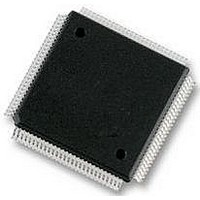XC68HC12A0CPV8 Freescale Semiconductor, XC68HC12A0CPV8 Datasheet - Page 200

XC68HC12A0CPV8
Manufacturer Part Number
XC68HC12A0CPV8
Description
IC, 16BIT MCU, 68HC12, 8MHZ, TQFP-112
Manufacturer
Freescale Semiconductor
Datasheet
1.MC912D60ACFUE8.pdf
(460 pages)
Specifications of XC68HC12A0CPV8
Controller Family/series
68HC12
No. Of I/o's
68
Eeprom Memory Size
1KB
Ram Memory Size
2KB
Cpu Speed
8MHz
No. Of Timers
1
Core Size
16 Bit
Program Memory Size
60KB
Peripherals
ADC
Lead Free Status / RoHS Status
Lead free / RoHS Compliant
- Current page: 200 of 460
- Download datasheet (5Mb)
Oscillator
12.5.2.2 Gain Margin
Technical Data
200
NRM measurement techniques can also generate misleading results
when applied to Automatic Level Control (ALC) style oscillator circuits
such as the D60x/Dx128x. Many NRM methods slowly increase series
resistance until oscillation stops. ALC-style oscillators reduce the gain of
the oscillator circuit after start-up to reduce current, so if the oscillator
tends to have more gain than optimum it will be more tolerant of
additional resistance after start-up than it will during the start-up process.
This means that NRM figures may be optimistic unless the method
verifies the NRM value by attempting to start the oscillator with the
additional resistance in-place. Worse, this phenomenon exaggerates
the difference between best- and worst-case NRM curves.
The Gain Margin of the oscillator indicates the amount the gain of the
oscillator can vary while maintaining oscillation. Specifically, Gain
Margin is:
Gain Margin = MIN(gain/minimum required gain, maximum allowed
gain/gain)
Just like NRM, Gain Margin may be dominated by either too much or too
little oscillator gain and an increase in gain may not increase Gain
Margin. Gain Margin is theoretically related to NRM since the maximum
allowed gain is (approximately) inversely proportional to ESR, and the
minimum required gain is (approximately) proportional to ESR, leaving
Gain Margin (approximately) inversely proportional to ESR.
The preferred method for specifying the oscillator, given a set of load
capacitor values, is to determine the maximum allowed ESR while
maintaining a worst-case Gain Margin of 2. Since Gain Margin is
proportional to ESR, this means the empirically measured NRM at the
worst-case point would be approximately twice the maximum allowed
ESR. However, since typical NRM is likely to be higher and most
measurement techniques do not account for ALC effects, actual NRM
measurements are likely to be much higher.
Oscillator
MC68HC912D60A — Rev. 3.1
Freescale Semiconductor
Related parts for XC68HC12A0CPV8
Image
Part Number
Description
Manufacturer
Datasheet
Request
R
Part Number:
Description:
Manufacturer:
Freescale Semiconductor, Inc
Datasheet:
Part Number:
Description:
Manufacturer:
Freescale Semiconductor, Inc
Datasheet:
Part Number:
Description:
Manufacturer:
Freescale Semiconductor, Inc
Datasheet:
Part Number:
Description:
Manufacturer:
Freescale Semiconductor, Inc
Datasheet:
Part Number:
Description:
Manufacturer:
Freescale Semiconductor, Inc
Datasheet:
Part Number:
Description:
Manufacturer:
Freescale Semiconductor, Inc
Datasheet:
Part Number:
Description:
Manufacturer:
Freescale Semiconductor, Inc
Datasheet:
Part Number:
Description:
Manufacturer:
Freescale Semiconductor, Inc
Datasheet:
Part Number:
Description:
Manufacturer:
Freescale Semiconductor, Inc
Datasheet:
Part Number:
Description:
Manufacturer:
Freescale Semiconductor, Inc
Datasheet:
Part Number:
Description:
Manufacturer:
Freescale Semiconductor, Inc
Datasheet:
Part Number:
Description:
Manufacturer:
Freescale Semiconductor, Inc
Datasheet:
Part Number:
Description:
Manufacturer:
Freescale Semiconductor, Inc
Datasheet:
Part Number:
Description:
Manufacturer:
Freescale Semiconductor, Inc
Datasheet:
Part Number:
Description:
Manufacturer:
Freescale Semiconductor, Inc
Datasheet:










